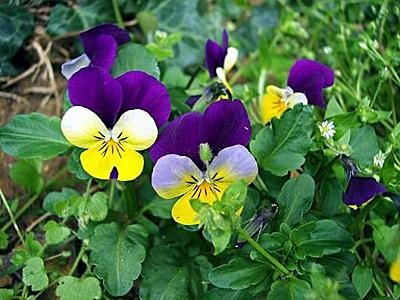Horned violet: methods of reproduction and care

Often in a summer cottage you can find an attractive plant with purple, white or light blue flowers and a yellow eye inside. This is a horned violet. The plant is so named because the back side has a hollow outgrowth that resembles a small horn. Violet does not require special care, but you should know some subtleties when growing and plant propagation.
Content:
- Features of horned violet
- Types of violet varieties and flower care
- How to propagate violets correctly
Features of horned violet
Horned violet (botanical name Viola cornuta) is a perennial plant with low, highly branched stems and reaches a height of 15-25 cm. It is a representative of the large violet family.
The leaves are elongated, oval-shaped and dark green. Unlike other species of the violet family, this plant has an interesting bud shape. The spur, curved at the back of the flower, resembles a horn. The size of the flower is from 3 to 5 cm. They come in different colors: white, yellow, blue, dark purple, etc.
The shade will depend on the selected variety. It usually blooms from late spring to early autumn. The perennial plant has spherical boxes that open with flaps. These are the fruits of the horned violet. Therefore, it can reproduce not only using seeds, but also vegetatively.
Violet is an unpretentious plant. The best place for growth will be sunny places, but not in the open sun.Violet loves shade or partial shade and grows in moderately fertile or well-drained soils.
The plant will perfectly decorate a path in a personal plot; it looks good with roses, shrubs and trees. Therefore, violet is often used for decorative purposes.
Types of violet varieties and flower care

There are many varieties of horned violet. Each variety has its own shade. The most common are:
- Foxbrook Cream - creamy white flowers
- Boton Blue - blue flowers
- Gazelle - dark purple and white-blue flowers
- Ruby - bright red flowers
- Yellow perfection – yellow-golden flowers
- White perfection - white flowers with a yellow spot inside
- Victoria Cawthorn - lilac-pink flowers
- Charlotte – purple flowers
- Jersey Jam – purple flowers
- Altona - beige flowers
Each of the above varieties has its own shade, shape, size and height. Caring for violets is quite simple, but there are some features that need to be remembered.
Water the flowers you shouldn't do it too often. Moderate watering is optimal. You can refresh the plant by spraying in the morning and evening. You can use mineral or organic fertilizers in small quantities. They are added to settled water and used along with watering once a week.
To protect and improve the properties of the soil, mulching is used. Occasionally cover the soil with mulching materials to prevent drying out and weed growth. Drainage stones, wood chips, gravel and moss are used as mulch. To stimulate flowering and plant growth, regrown shoots must be trimmed, and flowers that have already bloomed must be separated.
Due to lack of sunlight, slugs may appear on violets. To get rid of them, there is an effective way: add 25% ammonia (150 g) to a bucket of water. Stir the mixture well and spray the areas damaged by slugs.
When watering with cold water, brown spots may appear on the leaves of the plant. To avoid this, you must use settled water at room temperature.
If the violet leaves have lost their elasticity and have a dusty appearance, then this is a sign of rotting roots. The reason for this may be excess moisture.
Proper care and favorable conditions for cultivation - the main requirements for propagating violets.
How to propagate violets correctly

Most often, violets are propagated by seeds, but some hybrids can have vegetative propagation. For them, cuttings or division of the bush are used. From one already faded violet, about 30 new plants can be obtained by division.
First, the seedlings need to grow.
It can also be propagated by sowing in open ground. Seedlings are grown from February to April. The second method of propagation is advisable to carry out in spring or autumn. After sowing the seeds, the first flowers appear within 3 months.
Seeds can be purchased at a specialty store or plant pollen can be transferred from the pistil to the stamen using a toothpick. If everything is done correctly, then pollination occurs, the ovary develops and a capsule is formed. The seeds in the box will already ripen in 6 months.
Another way to propagate violets is to germinate seeds in protected ground. Pour soil into boxes or containers, pre-feed and disinfect. Calcinate the soil with high temperature, and then treat with Fungicide. This solution prevents the occurrence of fungal diseases.
The process of sowing violet seeds is as follows:
Make furrows in the prepared soil and place the seeds. Next, sift the seed through a sieve. Water the seeds and cover with film to create a greenhouse effect. Attach labels to the container indicating the sowing date and variety name.
Place the container in a cool place. The temperature should not exceed 18 degrees.
It is necessary to monitor soil moisture and prevent drying out. You can see the first seedlings in just a few weeks. As soon as the first shoots appear, the container must be moved to a warmer place.
After the first green leaves appear, remove the greenhouse and move the seedlings into pots.
If you carry out the propagation technology correctly, then very soon the horned violet will delight others with its attractive appearance.
Interesting information about the vegetable garden










